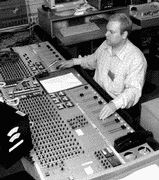Audio Engineering
Audio Engineering
Audio engineering is a part of audio science dealing with the recording and reproduction of sound through mechanical and electronic means. The field of audio engineering draws on many disciplines, including acoustics, psychoacoustics, and music. Unlike acoustical engineering, audio engineering generally does not deal with noise control or acoustical design. However it should be noted than an audio engineer is often more affiliated with technician work rather than as engineering, due to the lack of mathematics and science involved in mastering this field. Audio engineering is different from Acoustical Engineering, which heavily relies on the underlying physics and mathematics of sound waves and their propagation.
Practitioners...
An audio engineer is someone with experience and training in the production and manipulation of sound through mechanical means. As a professional title, this person is sometimes designated as a sound engineer instead. An informal name might be a "sound guy" and/or an "audio guy". A person with one of these titles is commonly listed in the credits of many commercial music recordings (also in other productions that include sound, such as movies).
Audio engineers are generally familiar with the design, installation, and/or operation of sound recording, sound reinforcement, or sound broadcasting equipment. In the recording studio environment, the audio engineer or recordist is a person recording, editing, manipulating, mixing and mastering sound by technical means in order to realize an artist's or record producer's creative vision. While usually being associated with music production, an audio engineer may be involved in dealing with sound for a wide range of applications, including post-production for video and film, live sound reinforcement, advertising, multimedia, broadcasting.
Audio engineers operate mixing consoles, microphones, signal processors, tape machines, digital audio workstations, sequencing software and speaker systems. Commonly an audio engineer is responsible for the technical aspects of a sound recording or other audio production and works together with a record producer or director, although the engineer's role is quite may also integrated with that of the producer.
In typical sound reinforcement applications, audio engineers often assume the role of producer, making artistic decisions along with technical ones.
It's worth noting that a formal engineering degree is usually worth nothing if it's not accredited by a national or international accreditation organization, such as EURING, NORDING.
Audio Mixing...
Audio mixing is used for sound recording, audio editing and sound systems to balance the relative volume and frequency content of a number of sound sources. Typically, these sound sources are the different musical instruments in a band or vocalists, the sections of an orchestra and so on.
Sometimes audio mixing is done live by an sound engineer or recording engineer, for example at rock concerts and other musical performances where a public address system (PA) is used. A typical concert has two mixers, one located in the audience to mix the front of house speakers heard by the audience, and the other is located at the side of the stage, mixing for the monitor speakers positioned directly in front of the performers so that they can hear one another.
Another example of live mixing is a DJ mixing two records together. Break beats are created by mixing between identical breaks. Often the end of one pre-recorded song is mixed into another so that the transition is seamless, which is done through beat-matching or beat-mixing, and possibly pitch control.
At other times, audio mixing is done in studios as part of multitrack recording in order to produce digital or analog audio recordings, or as part of an album, film or television program.
An audio mixing console, or mixing desk, or mixing board, has numerous rotating controls (potentiometers) and sliding controls (faders which are also potentiometers) that are used to manipulate the volume, the addition of effects such as reverb, and frequency content (equalization) of audio signals. On most consoles, all the controls that apply to a single channel of audio are arranged in a vertical column called a channel strip. Larger and more complex consoles such as those used in film and television production can contain hundreds of channel strips. Many consoles today, regardless of cost, have automation capabilities so the movement of their controls is performed automatically, not unlike a player piano. A recent trend is to use a "control surface" connected to a computer. This eliminates much of the electronics in a conventional console as the actual mixing work is done digitally by the computer.
Audio mixing on a personal computer is also gaining momentum. More and more independent artists are starting to use their personal computers for digital recording and mixing their work. Audio editing on the computer is also easy and generally preferred.
A recent trend is mixing to 5.1, which is "surround" audio. This requires 6 channels of audio: left, center, right, left rear, right rear, and low frequencies (sub-woofer). In commercial release, only DVD video has a standard. The demand for 5.1 in the audio and music domain was once small but has recently increased dramatically, along with the introduction of 7.1 & 9.1 surround channel audio.
Legendary Mix Engineers, such as Bob Clearmountain, have greatly influenced, and continue to influence the sound of modern music.
